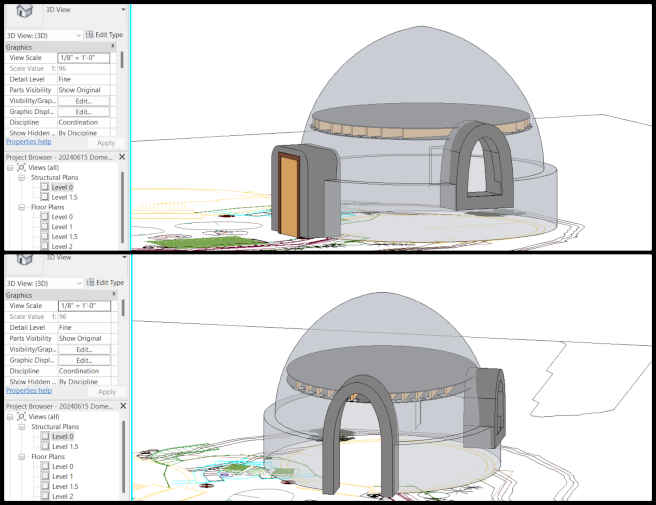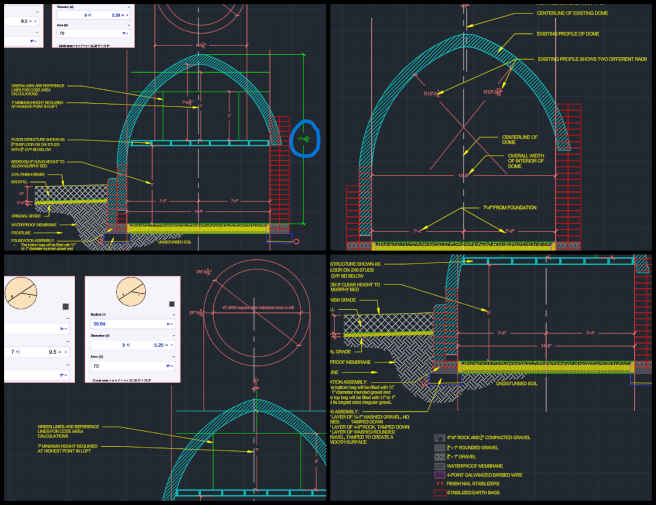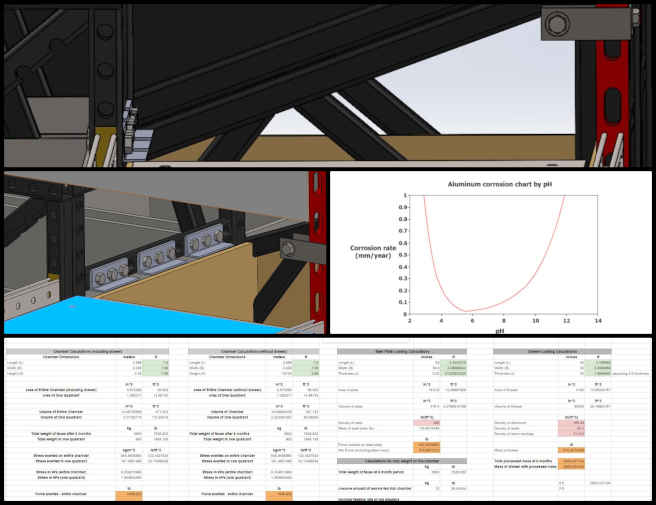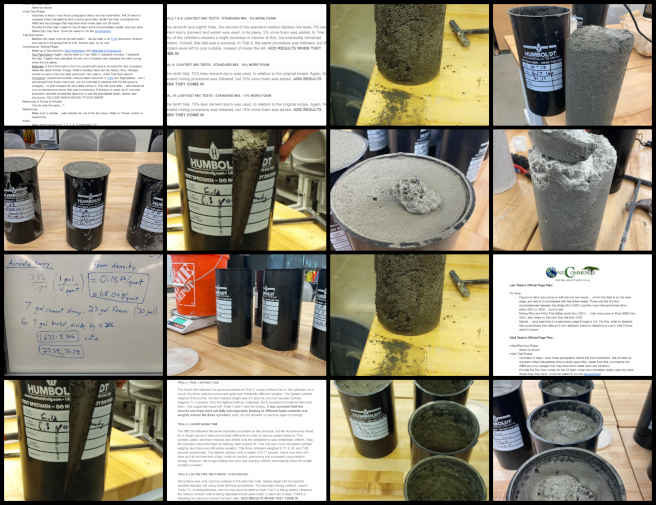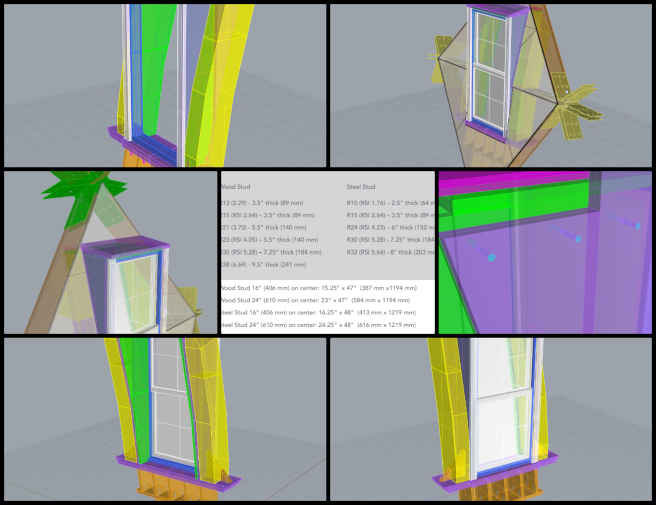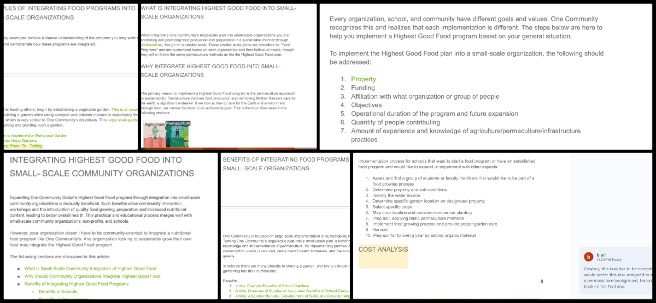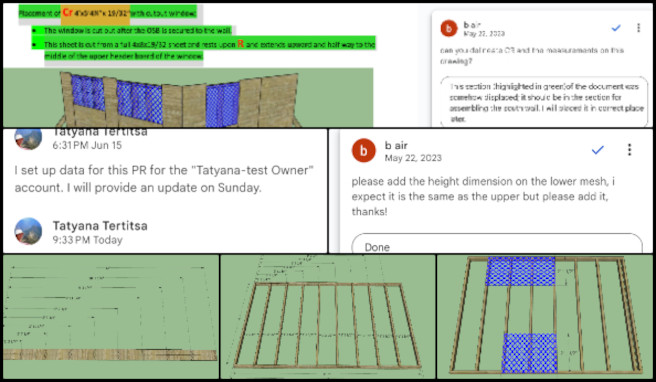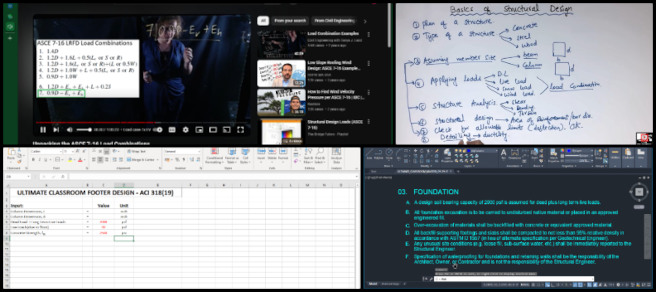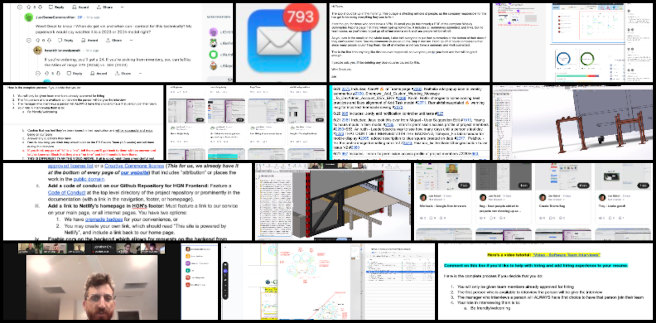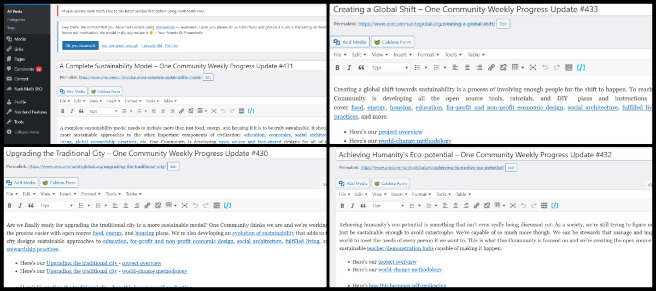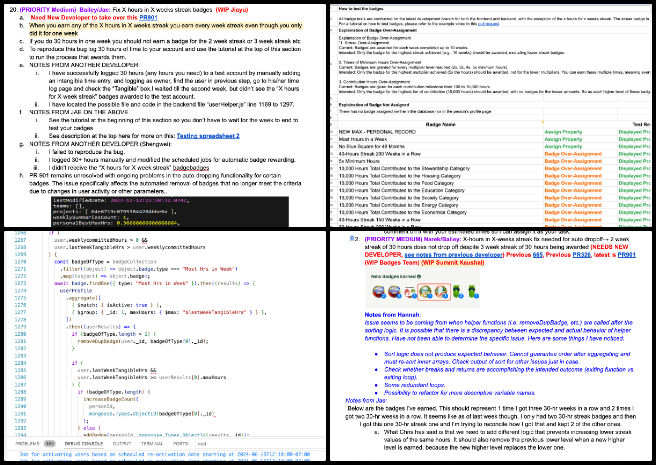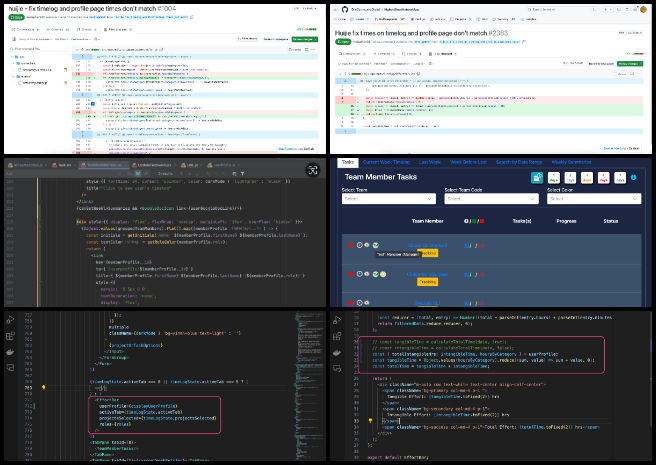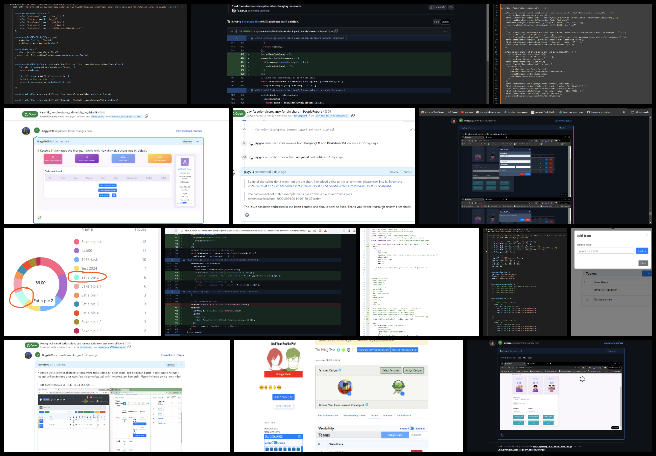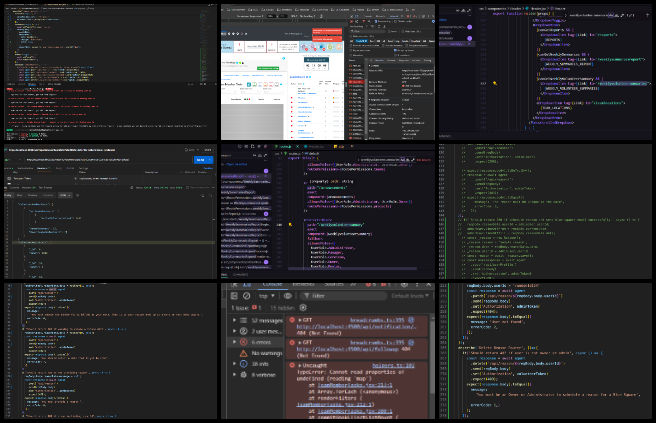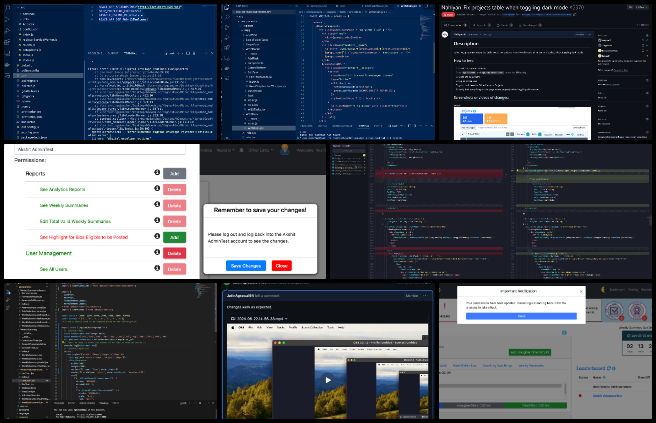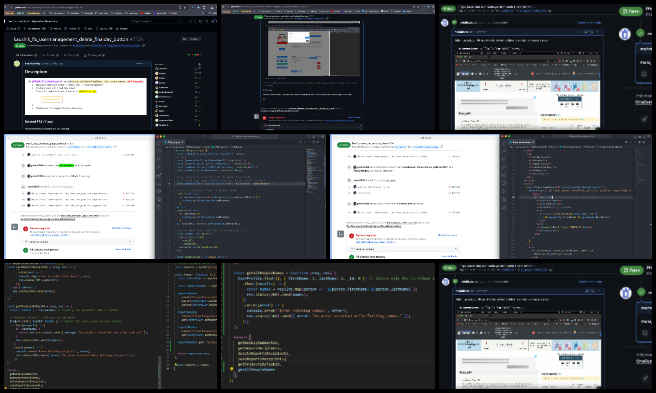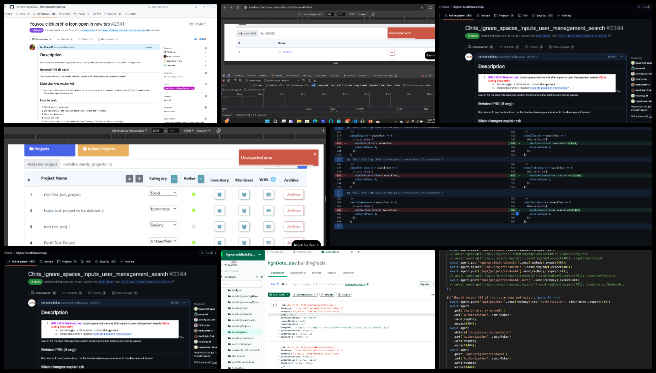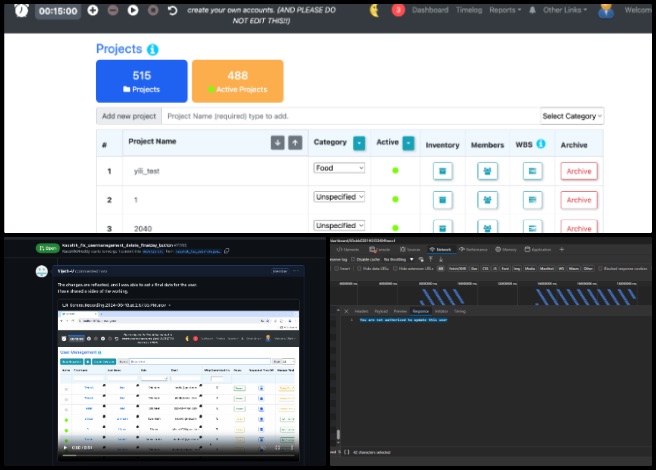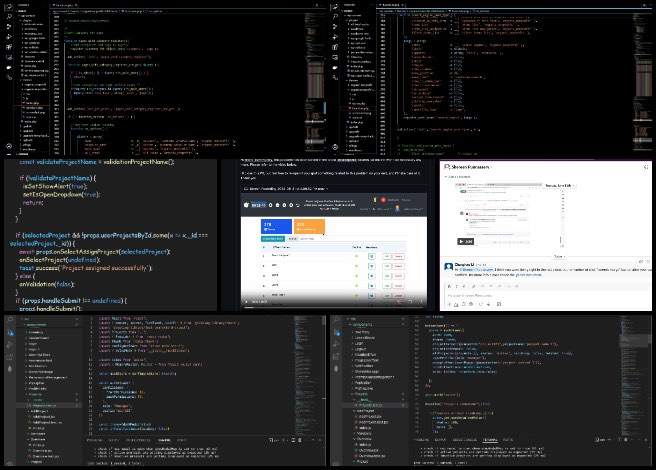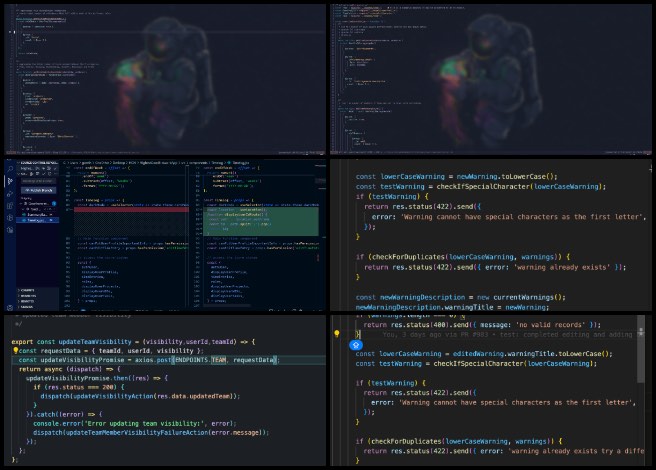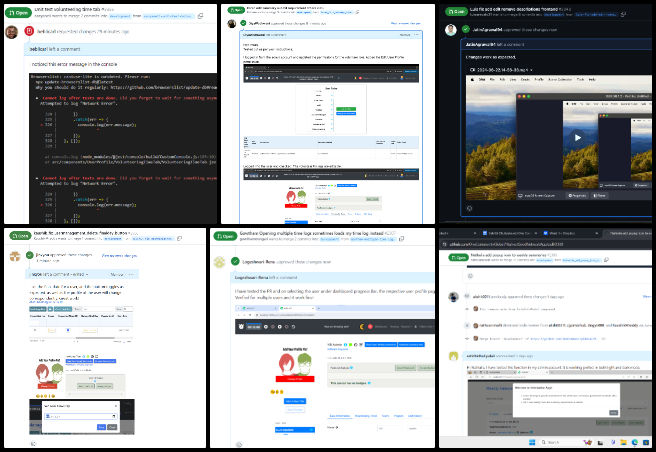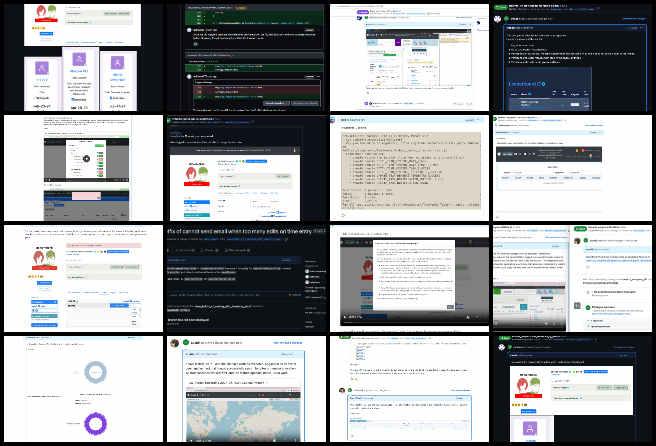A Solution to Persistent Global Challenges – One Community Weekly Progress Update #588
We believe we have a solution to persistent global challenges. By developing a model that becomes self-replicating, we aim to foster a global collaboration of teacher/demonstration hubs, all working together for “The Highest Good of All“. One Community is open sourcing and free sharing everything needed to create replicable versions of them. This includes sustainable and DIY-replicable versions of food, energy, housing, education, for-profit and non-profit economic design, social architecture, fulfilled living, global stewardship practices, and more.
- Here’s our project overview
- Here’s our world-change methodology
- Here’s how this becomes self-replicating
- Here’s how we are open source and free-sharing all the do-it-yourself designs
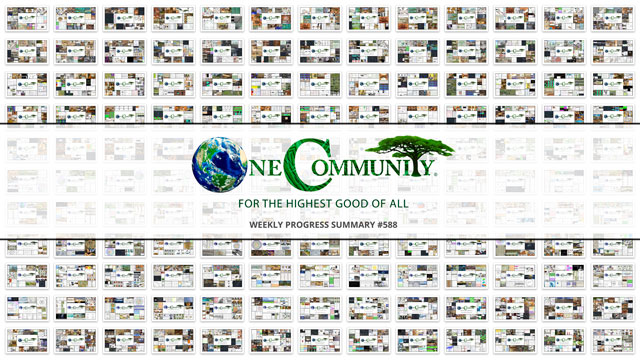
OUR MAIN OPEN SOURCE HUBS
Click on each icon to be taken to the corresponding Highest Good hub page.
One Community’s physical location will forward this movement and solution to persistent global challenges as the first of many self-replicating teacher/demonstration communities, villages, and cities to be built around the world. This is the June 24th, 2024 edition (#588) of our weekly progress update detailing our team’s development and accomplishments:
A Solution to Persistent Global Challenges
One Community Progress Update #588
DONATE | COLLABORATE | HELP WITH LARGE-SCALE FUNDING
CLICK HERE IF YOU’D LIKE TO RECEIVE AN EMAIL EACH WEEK WHEN WE RELEASE A NEW UPDATE
YOU CAN ALSO JOIN US THROUGH SOCIAL MEDIA
ONE COMMUNITY WEEKLY UPDATE DETAILS
NOTE: OUR SOFTWARE WENT DOWN THIS LAST WEEK DUE PROBLEMS OUR HOST WAS HAVING. THIS SIGNIFICANTLY DISRUPTED OUR TEAM’S ABILITY TO LOG AND REPORT ON THEIR WORK PROPERLY. FOR THIS REASON, THIS UPDATE DOESN’T INCLUDE EVERYONE’S WORK AND IS NOT A COMPLETE ONE.
HIGHEST GOOD HOUSING PROGRESS
 One Community is creating a solution to persistent global challenges through Highest Good housing that is artistic and beautiful, more affordable, more space efficient, lasts longer, DIY buildable, and constructed with healthy and sustainable materials:
One Community is creating a solution to persistent global challenges through Highest Good housing that is artistic and beautiful, more affordable, more space efficient, lasts longer, DIY buildable, and constructed with healthy and sustainable materials:
- Learn about: Our Upcoming Crowdfunding Campaign
- Learn about the different village models as a solution to persistent global challenges: 7 Sustainable Village Models
- Visit the open source portals for the first two: Earthbag Village OS Hub | Straw Bale Village OS Hub
This week, Boya Wang (Architecture Designer) continued her work helping with the design for the Earthbag Village 4-dome home. Boya worked on the revision of doors and windows based on the AutoCAD drawing for Week 6, addressed the columns for the free-standing patio, and double-checked if the door and window dimensions were accurate in AutoCAD and met California Code. The windows and doors remain updated with adjustable door heights. The Earthbag Village is the first of 7 to be built as the housing component of One Community’s open source model as a solution to persistent global challenges. See his work in the collage below.
Michaela Silva (Architect) continued her work on the Earthbag Village architectural designs. This week, Michaela updated the AutoCAD titleblock to align with industry standards. She studied 4-Dome details and furniture and began coordinating the final Murphy bed design with AutoCAD drawings. Additionally, she worked on creating 4-Dome base of wall details, addressing differences from the 3-Dome foundation due to the buttress wall required for added support. During a foundation/footer study, she identified dimensional errors in existing dome sections that slightly affect the dome profile. After updating the footer/foundations accordingly, Michaela determined the proposed dome height necessary to meet minimum area and height requirements for habitable lofts. The Earthbag village forms the basis of One Community’s open source model as a solution to persistent global challenges. See her work in the collage below.
Rizwan Syed (Mechanical Engineer) also continued helping finish the Vermiculture Toilet designs. This week, Rizwan concentrated on designing bracket assemblies in SolidWorks for the vermiculture eco-toilet chamber’s removable slider blocks. He developed a preliminary L-corner bracket to act as a guide for the slider block, which is manipulated through a mechanical winch. To reinforce the structure, he added support pillars to the rear and mid-planes, ensuring the alignment of the L-shaped pieces with these pillars. After reviewing existing corner brackets used in commercial applications, Rizwan decided to use stainless steel for its durability and updated the slider block design to align seamlessly with both the outermost unistrut and the corner bracket. He also investigated the corrosion characteristics of similar metals in contact to assess the longevity of the L brackets. Additionally, he updated the vermiculture loading calculations spreadsheet by introducing simple color coding to differentiate between fixed and calculated values, thereby simplifying the stress analysis process. The vermiculture toilets and other sustainable human waste processing technologies form the basis of One Community’s open source model as a solution to persistent global challenges. Here are a few photos showing examples of his work.
AIRCRETE TEAM
The Aircrete Testing Team’s summary, covering their work on Aircrete Compression Testing was managed by John Sullivan (CBU Chemical Engineering Student) and includes Jonathan Crago (Civil Engineering Student), Preston Thompson (Civil Engineering Student), and Tad Matlock (Environmental Science Student). This week, Jonathan worked with his team to create test cylinders of aircrete using three different mixing types: Dome Gaia, Aircrete Harry, and Standard Mix. They varied the levels of foam, soap, cement, and mixing times to achieve a consistent and stable mix. Jonathan also assisted the team in recording all the results onto the Final Doc spreadsheet and the Trial Data doc. Tad reviewed work and data from past Aircrete volunteer teams to begin formatting his writing for the main Aircrete webpage. He took note of possible additions and edits to the existing content, creating a comprehensive outline. Also, he began writing the official trial summaries based on the current lab team’s data. So far, 10 trials have been documented in detail. These aircrete tests contribute to the housing aspect of One Community’s open source model as a solution to persistent global challenges. See below for some of the pictures related to this work.
DUPLICABLE CITY CENTER PROGRESS
 One Community is creating a solution to persistent global challenges through a Duplicable and Sustainable City Center that is LEED Platinum certified/Sustainable, can feed 200 people at a time, provide laundry for over 300 people, is beautiful, spacious, and saves resources, money, and space:
One Community is creating a solution to persistent global challenges through a Duplicable and Sustainable City Center that is LEED Platinum certified/Sustainable, can feed 200 people at a time, provide laundry for over 300 people, is beautiful, spacious, and saves resources, money, and space:
- Learn about this building and it’s function as a solution to persistent global challenges: Duplicable City Center Open Source Hub
This week, Nika Gavran (Industrial Designer) continued her work on the Duplicable City Center dormer window installation plans. Nika focused on advancing the dormer window assembly instructions, primarily by implementing fasteners and screws for the new dormer window design. She finished placing most of the screws into the CAD for the entire dormer window. Once all screws are determined, she will establish the order of fastening the pieces. Additionally, Nika received feedback on incorporating more sustainable insulation, prompting her to review One Community guidelines and research insulation properties and regulations. She has implemented rock wool into the latest design. The Duplicable City Center is a foundational part of One Community’s open source model as a solution to persistent global challenges. See below for some of the pictures related to this work.
HIGHEST GOOD FOOD PROGRESS
 One Community is creating a solution to persistent global challenges through Highest Good food that is more diverse, more nutritious, locally grown and sustainable, and part of our open source botanical garden model to support and share bio-diversity:
One Community is creating a solution to persistent global challenges through Highest Good food that is more diverse, more nutritious, locally grown and sustainable, and part of our open source botanical garden model to support and share bio-diversity:
- Learn about the structures we’ll build first as a solution to persistent global challenges: Hoop House Hub | Aquapini & Walipini Open Source Hub
- See what we’ll be growing first as a solution to persistent global challenges: Gardens & Hoop Houses | Large-scale Structures | Food Forest | TA
This week, the core team continued updating and expanding the Highest Good Food tools, equipment, materials, and supplies document by adding new items. They finalized a comprehensive review of the School Integration program which is designed for small-scale permaculture gardening in schools and other organizations. It is from One Community’s permaculture plans for feeding groups of people which offers step-by-step implementation instructions. Highest Good Food is an important part of our solution to persistent global challenges using One Community’s open source plans. See their work in the collage below.
Because the software was down, the core team could only do a little work on the Highest Good Network PRs testing, confirming 1 fixed PR set. These PRs were BE619 and FE826 related to the “New Max-Personal Record Award” issue for the “Tatyana-test Owner” account. They then focused on updating the Chickens Coop, Step-by-step Build” GoogleDoc, focusing on correcting text, ensuring grammar consistency, and verifying font type and size across pages 3-57. They also addressed comments following issue corrections and updated associated images accordingly. See the Highest Good Society and Highest Good Food pages for more on how this relates to a solution to persistent global challenges. The collage below shows some of their work
HIGHEST GOOD EDUCATION PROGRESS
 One Community is creating a solution to persistent global challenges through Highest Good education that is for all ages, applicable in any environment, adaptable to individual needs, far exceeds traditional education standards, and more fun for both the teachers and the students. This component of One Community is about 95% complete with only the Open Source School Licensing and Ultimate Classroom construction and assembly details remaining to be finished. With over 8 years of work invested in the process, the sections below are all complete until we move onto the property and continue the development and open sourcing process with teachers and students – a development process that is built directly into the structure of the education program and everything else we’re creating too:
One Community is creating a solution to persistent global challenges through Highest Good education that is for all ages, applicable in any environment, adaptable to individual needs, far exceeds traditional education standards, and more fun for both the teachers and the students. This component of One Community is about 95% complete with only the Open Source School Licensing and Ultimate Classroom construction and assembly details remaining to be finished. With over 8 years of work invested in the process, the sections below are all complete until we move onto the property and continue the development and open sourcing process with teachers and students – a development process that is built directly into the structure of the education program and everything else we’re creating too:
- Program Overview and how this fits in as a solution to persistent global challenges: Education Open Source Hub
- How the components work together as a solution to persistent global challenges: How to use the Education for Life Program
- Lesson Plans for Life – Lesson Plans How-to
- Foundations of Outstanding Leaders, Teachers, and Communicators
- Curriculum for Life
- Teaching Strategies for Life
- Learning Tools and Toys for Life
- Evaluation and Evolution
This week, Apoorv Pandey (Mechanical Engineer) continued helping with the engineering details for The Ultimate Classroom part of the Highest Good Education component. He finished working on the title block formatting for the detail report and submitted a first draft of the report for review and received constructive feedback from his senior engineer, Brian Muigai Mwaniki (Structural Engineer), who led a management meeting to discuss the ongoing presentation of these works to optimize it. Apoorv is further revising the scope of the project to include other factions of the project in the report. The calculations are yet to be evaluated and included in the report, which is the final aspect of his project section. The One Community model of combining forward-thinking education with sustainably built classrooms like this are an excellent example of a solution to persistent global challenges. See the collage below for their work.
Brian Mwoyowatidi (Graduate Structural Engineer) continued helping with the engineering details for The Ultimate Classroom part of the Highest Good Education component. He completed the summary report on the key provisions of ACI 318-2019 regarding foundations. This summary has positioned him to review the structural engineering details more effectively. He is currently reviewing these details and has begun an Excel spreadsheet to perform necessary calculations and organize important design data for One Community’s open-source project. The One Community model of combining forward-thinking education with sustainably built classrooms like this are an excellent example of a solution to persistent global challenges. See the collage below for their work.
HIGHEST GOOD SOCIETY PROGRESS
 One Community is creating a solution to persistent global challenges through a Highest Good society approach to living that is founded on fulfilled living, the study of meeting human needs, Community, and making a difference in the world:
One Community is creating a solution to persistent global challenges through a Highest Good society approach to living that is founded on fulfilled living, the study of meeting human needs, Community, and making a difference in the world:
- Read the Highest Good society overview: Highest Good Society
- Learn about the model for fulfilled living and sharing: A Day in the Life
- Learn about the 4 economic models: RBE | For-profit | Non-profit | Entrepreneurship
This week, the core team completed over 50 hours managing One Community volunteer-work review not included above, emails, social media accounts, web development, new bug identification and bug-fix integration for the Highest Good Network software, and interviewing and getting set up new volunteer team members. They also shot and incorporated the video above that talks about a solution to persistent global challenges and how a solution to persistent global challenges is a foundation of the bigger picture of everything One Community is doing. The pictures below show some of this work.
Arun Chandar Ganesan (Volunteer Data Analyst and SEO and Social Media Assistant) worked on improving webpage SEO, reviewing numerous pages and working on more than 20 which includes some previously abandoned ones. Additionally, he managed and coordinated the scheduling of posts on One Community’s social media platforms such as Facebook, Instagram, Pinterest, and LinkedIn, and regularly updated the tutorials. His work on social media helps One Community to broaden our reach and spread our message as a solution to persistent global challenges. The following images show his work for the week.
ADMINISTRATION TEAM
The Administration Team’s summary, covering their work administrating and managing most of One Community’s ongoing process for creating a solution to persistent global challenges was managed by Sneka Vetriappan (Data Analyst) and includes Jessica Fairbanks (Administrative Assistant), and Ratna Meena Shivakumar (Data Analyst and Admin). This week, Jessica reviewed the Blue Steel Team’s summaries, creating a collage of their work, and updated her web page with the final product. She also evaluated the experiences of potential volunteers, preparing for and conducting two interviews for One Community. Ratna focused on essential tasks for OC Administration, including preparing detailed weekly summaries and assembling collages. She enhanced the formatting, SEO, and imagery for food and core team updates, scheduled engaging posts for Facebook and Instagram, and organized folders for the used images. Ratna also reviewed Arun’s blogs and maintained proactive communication with team members, including Rachna and Sneka. Meanwhile, Sneka did her part helping as a solution to persistent global challenges as she concentrated on SEO optimization by updating older pages and implementing feedback from previous weeks. She reviewed time log entries for accuracy, providing insightful feedback, and following up on earlier comments. Sneka also updated the webpage with the latest weekly summaries and collages and prepared reviews of summaries and images. One Community’s model for creating a solution to persistent global challenges includes developing and maintaining a supportive administration team like this. You can see the work for the team in the image below.
GRAPHIC DESIGN TEAM
The Graphic Design Team’s summary was managed by Zuqi Li (Administrative Assistant and Economic Analyst) and included Ashlesha Navale (Graphic Designer) and Jasmine Soria (Graphic Designer), covering their work on graphic designs for us as a solution to persistent global challenges. This week, Ashlesha worked on creating two volunteer announcements, including two bio images and two announcement images. She also created web content for both announcements. She researched and curated a collection of nature-based background images and different theme-based images for creating social media images and produced two social media images. Jasmine focused on final edits to previous graphics, learning to export files in maximum quality for clearer and better presentation despite larger file sizes. She was assigned a biography, uploaded to WordPress, edited the accompanying photo, and created the announcement using the designated template. Additionally, she started working on a few more social media graphics, which are still in progress. See the Highest Good Society pages for more on how this contributes to our mission as a solution to persistent global challenges. See the collage below to view some of their work.
HIGHEST GOOD NETWORK PROGRESS
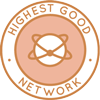 One Community is creating a solution to persistent global challenges through open source Highest Good Network® software that is a web-based application for collaboration, time tracking, and objective data collection. The purpose of the Highest Good Network is to provide software for internal operations and external cooperation. It is being designed for global use in support of the different countries and communities replicating the One Community sustainable village models and related components.
One Community is creating a solution to persistent global challenges through open source Highest Good Network® software that is a web-based application for collaboration, time tracking, and objective data collection. The purpose of the Highest Good Network is to provide software for internal operations and external cooperation. It is being designed for global use in support of the different countries and communities replicating the One Community sustainable village models and related components.
- Learn about our open source community collaboration and management software and how it contributes as a solution to persistent global challenges: The Highest Good Network
ALPHA SOFTWARE DEVELOPMENT TEAM
This week, the Alpha Team’s summary, covering their work on the Highest Good Network software was managed by Zuqi Li (Administrative Assistant and Economic Analyst) and includes Anand Seshadri (Software Engineer), Jordy Corporan (Software Engineer) and Nathalia Carnevalli (Full Stack Software Developer). The Highest Good Network software is how we will manage and measure our progress as a solution to persistent global challenges using our social architecture, construction, production, and maintenance processes. This week, Anand focused on addressing the challenge of ensuring a persistent horizontal scrollbar below 576px on responsive screens. He adjusted CSS settings and applied overflow-x: auto to the body, aiming to maintain the horizontal scrollbar’s visibility.
Anand updated media queries to ensure proper vertical scrolling while keeping the horizontal scrollbar visible. He utilized the table-responsive-sm class to enable horizontal scrolling within the table’s container and implemented specific CSS for html and body elements to enforce horizontal scrolling below 576px. Despite these efforts, the desired outcome of visible horizontal scrolling and unaffected vertical scrolling was not achieved as expected. Further refinements are necessary to resolve these issues. Jordy ran into several blockers with the email controller unit tests but that did not stop him from contributing. He proceeded to refactor his code structure in his unit tests for the roles controller. Nathania did her part helping as a solution to persistent global challenges as she worked on filtering projects by person name on both the frontend and backend. She created an API that accepts a full name, splits it into first and last names, and performs a database search based on the provided name value. Additionally, she implemented the frontend to send requests to the API whenever a user types a letter. See the Highest Good Society and Highest Good Network pages for more on how this relates to a solution to persistent global challenges. View some of the team’s work in the collage below.
BADGES BUGS SOFTWARE DEVELOPMENT TEAM
The Badges Bugs Team’s summary overseeing advancements in the Highest Good Network software was managed by Summit Kaushal (Backend Software Developer). The Highest Good Network software is how we will manage and measure our progress as a solution to persistent global challenges using our social architecture, construction, production, and maintenance processes. Summit searched for potential team members and sent out a few direct messages. He recruited and reviewed manager roles and various other documents. He also further examined the PRs associated with the xhours in x weeks streak, identifying areas needing work despite current bugs. The badge test document for streak-related issues was reviewed, and efforts were made to debug PR 901. See the Highest Good Society and Highest Good Network pages for more on how this relates to a solution to persistent global challenges. The collage below shows some of this work.
BINARY BRIGADE SOFTWARE DEVELOPMENT TEAM
The Binary Brigade Team’s summary overseeing advancements in the Highest Good Network software was managed by Ruiqi Liu (Administrative Assistant) and includes Aaryaneil Nimbalkar (Software Developer), and Huijie Liu (Software Engineer). The Highest Good Network software is how we will manage and measure our progress as a solution to persistent global challenges using our social architecture, construction, production, and maintenance processes. Aaryaneil created unit tests for Members/Members.js to ensure it does not error out due to missing tests, renders the Members component, fetches all members on mount, toggles to show active members only, calls findUserProfiles when a user types in the search input, disables the search input when toggling show active members only, and calls assignAll when the All button is clicked. Additionally, he also developed unit tests for the LoginPrivileges component to test rendering keyName and value, applying the darkMode class, applying the legend square color, rendering radio buttons, checking selected input, and handling input change.
Huijie completed the task of fixing discrepancies between the time log and profile page times after confirming further criteria for website behaviors. She modified the mongoose query for getting the time entry data for the time log page to include those related to archived projects, tested her code, and manually checked about 20 users. Huijie submitted backend PR 1004 and frontend PR 2383. See the Highest Good Society and Highest Good Network pages for more on how this relates to a solution to persistent global challenges. The collage below shows some of this work.
BLUE STEEL SOFTWARE DEVELOPMENT TEAM
The Blue Steel Team’s summary, presenting their work on the Highest Good Network software was managed by Jingyi Jia (Software Engineer, Team Manager), and includes Bhuvan Dama (Full stack Developer), Imran Issa (Software Developer), Jay Srinivasan (Software Engineer), Parth Rasu Jangid (Software Developer), Ramakrishna Aruva (Software Engineer), and Tzu Ning “Leo” Chueh (Software Engineer). The Highest Good Network software is how we will manage and measure our progress as a solution to persistent global challenges using our social architecture, construction, production, and maintenance processes. This week, Bhuvan focused on HGN Software Development, improving code coverage for TableFilter.jsx from 70% to 86.6% by implementing additional test cases. He encountered difficulties creating a GitHub branch to check in changes, likely due to codebase issues and resolved using a workaround. Managing node module inconsistencies was also a significant time investment. Imran concentrated on reviewing high-priority pull requests and provided feedback, awaiting support for test cases from the previous week. Jay addressed feedback on a PR related to a people report pie chart color discrepancy by aligning task legends with chart colors and enhancing the header UI for smaller viewports, utilizing the useLocation hook to prevent display on the login screen and fixing CSS alignment issues. He initiated a PR for these updates and sought input from the project lead on mobile optimization, also addressing a bug ticket concerning default password settings.
Jingyi reviewed eight high-priority pull requests, addressing issues from team location search errors to dark mode functionality on the reports page. Additionally, Jingyi worked on a permission management feature for editing 5-digit sorting codes, though it currently displays as “edit 4-digits.” Parth collaborated on debugging Imran’s frontend testing code, resolving an Async Timeout error hindering emailSender function testing in the timeOffRequestController. Ramakrishna did his part helping as a solution to persistent global challenges as he completed initial frontend updates, addressing a warning message issue and fixing a missing ‘select no code’ option after team code changes. He also began developing a more inclusive regex for team codes, achieving 90% functionality and planning further refinements. Tzu Ning reviewed code handling team additions and deletions, strategizing a refactoring plan for the UserTeamsTable component to enhance state management and implement immediate UI updates. See the Highest Good Society and the Highest Good Network pages to learn more on how their work contributes to creating a solution to persistent global challenges. See below to view their work.
CODE CRAFTERS SOFTWARE DEVELOPMENT TEAM
The Code Crafters Team’s summary, covering their work on the Highest Good Network software, was managed by Ruiqi Liu (Administrative Assistant) and includes Carlos Gomez (Full-stack Software Developer), and Xiaoyu Chen (Software Engineer). The Highest Good Network software is how we will manage and measure our progress as a solution to persistent global challenges using our social architecture, construction, production, and maintenance processes. Carlos addressed issues related to FPR 2310, fixing the user name display for larger screen sizes and solving the issue causing the page to turn blank during loading. He also engaged with the weekly-summary-dashboard team (WSDT), reviewing the API proposed by Aby Liu and providing feedback. He explored the redux system of the app and started reviewing the frontend proposal from Harsh, identifying discrepancies in route naming in routes.js and fetching errors on the /dashboard page. While fixing these discrepancies, updates to FPR 2310 and BPR PT97 were made, including merging development branches and resolving conflicts.
Xiaoyu responded to Imran Issa’s request to review the pull request for creating user management tab permissions and followed up by checking the frontend ActiveCell.test.js. She completed the backend unit tests and consulted HarshB, choosing to work on the Hours Completed Bar Chart. Xiaoyu also progressed with the reasonSchedulingController router tests, passing seven. See the Highest Good Society and Highest Good Network pages for more on how this relates to a solution to persistent global challenges. The collage below shows some of this work.
DEV DYNASTY SOFTWARE DEVELOPMENT TEAM
The Dev Dynasty Team’s summary, covering their work on the Highest Good Network software, was managed by Ruiqi Liu (Administrative Assistant) and includes Akshit Sharma (Software Engineer), Nahiyan Ahmed (Full Stack Software Developer), and Jatin Agrawal (Software Engineer). The Highest Good Network software is how we will manage and measure our progress as a solution to persistent global challenges using our social architecture, construction, production, and maintenance processes. Akshit’s work was focused on addressing two bugs. The first task involved adding a reminder to save changes on the Permissions Management page by creating a modal that pops up when changes are made and remains visible until they are saved, eliminating the need to scroll to the bottom to save with a “Save Changes and Close” button. Changes were made in ReminderModal.jsx, PermissionManagement.jsx, PermissionManagement.css, and UserPermissionPopUp.jsx. The second task involved adding a loading spinning circle for the projects page when members don’t load, incorporating the logic into Members.jsx and updating the fetchAllMembers logic in projectMembers.js.
Jatin completed the task “Quick Setup Function Permissions” ahead of schedule and started a new task titled “Fix New People Added to Projects Not Showing Up as Resource to Add to Tasks.” Additionally, he completed the volunteer trends page for the “Weekly Volunteer Summary” bug and reviewed PR#2343 as requested by the maintainer. Nahiyan did his part helping as a solution to persistent global challenges as he completed PR 2370, which fixed an issue with the projects table not fully updating contents when toggling to or from dark mode by using a useEffect hook. He also made a commit for requested changes that altered the colors of the dropdown items and their backgrounds in the header. See the Highest Good Society and Highest Good Network pages for more on how this relates to a solution to persistent global challenges. The collage below shows some of this work.
EXPRESSERS SOFTWARE DEVELOPMENT TEAM
The Expressers Team’s summary, covering their work on the Highest Good Network software, was managed by Shereen Punnassery (Full Stack Software Engineer) and includes KyoSook Shin (Software Engineer). The Highest Good Network software is how we will manage and measure our progress as a solution to persistent global challenges using our social architecture, construction, production, and maintenance processes. This week, KyoSook made several significant updates and bug fixes across both frontend and backend systems. On the frontend, new fetchBMProjectMember routines were added in various files, including projectMemberAction.js, BMTimeLogCard.jsx, BMTimeLogMembers.jsx, projectMemberReducer.js, reducers/index.js, and utils/URL.js. A separate URL was introduced to retrieve timelogger information, and the React reducer was confirmed to work correctly after integrating timelogger-related API functions, with clear communication established between the client and server. On the backend, fetchProjectMembers router and controller routines were added in bmProjectController.js and bmProjectRouter.js to aggregate member information based on project ID. Efforts were made to analyze and fetch information from the userProfile model, resolving an issue with populating member information. It was discovered that the project model schema’s use of “teams” as both the field name and reference name caused errors in retrieving team information, necessitating a change in the field name. Additionally, attempts to populate each member’s assigned tasks revealed that the userProfile schema lacks task information, requiring a lookup in the Task schema for matching user IDs of project members.
Shereen worked on the reusable bulk update component. She created new files to display the list of reusables and also to update them. Additionally, she created reducer functions that determine how the state of an application changes in response to update actions. Shereen also created action creators to handle the data sent by the update reusable bulk form. Furthermore, she created a URL route for the reusable update page. See the Highest Good Society and Highest Good Network pages for more on how this relates to a solution to persistent global challenges. See the collage below for the team’s work this week.
GIT-R-DONE SOFTWARE DEVELOPMENT TEAM
The Git-R-Done Team’s summary, covering their work on the Highest Good Network software, was managed by Hiral Soni (Full Stack Developer) and includes Malav Patel (Software Developer), Sushmitha Prathap (Software Developer) and Youyou Zhang (Software Developer). The Highest Good Network software is how we will manage and measure our progress as a solution to persistent global challenges using our social architecture, construction, production, and maintenance processes. This week, Malav tackled various tasks to fix bugs in the DELETE_TIME_ENTRY_OTHERS feature and HGN software development. He made changes to restrict the permission of volunteers to delete owners/admins/managers’ Time Entry Logs, pushed the changes into his branch, and completed the task and testing. He solved many issues that arose during the bug-fixing phase. He also worked on an efficiency task to determine where HGN needs to improve performance.
Sushmitha fixed errors and ran final checks on the unit tests for the task controller. She updated the project controller branch with new changes from the development branch, resolved conflicts, and re-did the unit test for the project controller. Sushmitha worked on the remaining functions for the task controller and addressed a git error. Youyou did her part helping as a solution to persistent global challenges as she made progress on fixing the issue where new permission roles were not showing up in the permission role list. The app now correctly creates new roles with specific names and selected permissions, and the response handling ensures that an error caught by Axios does not display a success message. However, her changes currently require a manual refresh to update the permission role list. See the Highest Good Society and Highest Good Network pages for more on how this relates to a solution to persistent global challenges. See the collage below for the team’s work this week.
MOONFALL’S SOFTWARE DEVELOPMENT TEAM
Moonfall Team’s summary, covering their work on the Highest Good Network software, was managed by Xiaolai Li (Administrative Assistant) and includes Malav Patel (Software developer) and Vijeth Venkatesha (Full Stack Developer). The Highest Good Network software is how we will manage and measure our progress as a solution to persistent global challenges using our social architecture, construction, production, and maintenance processes. Malav addressed multiple issues to fix a bug in the DELETE_TIME_ENTRY_OTHERS feature and improve the HGN software development. Additionally, he implemented changes to restrict volunteers from deleting time entry logs of owners, admins, and managers. He then pushed these updates to his own branch. Vijeth completed reviews for two pull requests, PR 2366 and PR 2370. Following these reviews, he examined the documentation of the developer roles and responsibilities within the team. Additionally, Vijeth began analyzing the overall software structure to ensure alignment with project goals and best practices. See the Highest Good Society and Highest Good Network pages for more on how this relates to a solution to persistent global challenges. Look below for a collage of their work.
REACTONAUTS’ SOFTWARE DEVELOPMENT TEAM
Reactonauts’ Team’s summary, covering their work on the Highest Good Network software, was managed by Changhao Li (Software Engineer) and includes Dhairya Mehta (Software Engineer), Hetvi Patel (Full Stack Developer), Hoang Pham (Software Developer), Peterson Rodrigues (Full-Stack MERN Stack Developer) and Shiwani Rajagopalan (Software Engineer). The Highest Good Network software is how we will manage and measure our progress as a solution to persistent global challenges using our social architecture, construction, production, and maintenance processes. Changhao worked on unit test development, team time log management and the weekly team meeting. Dhairya resolved the “Fix Projects find user function” task and initiated the development of a sort and search function. Hetvi worked on documenting functionality post-completion and recorded instructional videos. She backed up and restored the live server database locally, added category code to a child theme, and managed data entry for dropdown options in the Highest Good Education search engine.
Hoang did his part helping as a solution to persistent global challenges as he focused on two of his previous pull requests: adding copy functionality and fixing the project report table (#2163) and addressing hours input issues in the task modal (#2135). Peterson enhanced project creation functionality in the user profile section and projects tab with new features this week. He introduced a cancel button during project creation and automatic project selection for easier user inclusion. He also refined category selection to exclusively appear for Owners and implemented various usability improvements. Shiwani focused on unit tests for the Projects module, adding 15 detailed test cases. She ensured the component was rendered without crashing using a mock Redux store and verified the presence of various headers and elements such as Projects, Project Name, Category, Active, Members, and WBS. Shiwani also checked the visibility of AddProjects HTML elements based on user permissions and tested loading elements when fetching data. See the Highest Good Society and Highest Good Network pages for more on how this relates to a solution to persistent global challenges. Look below for pictures of this work.
SKYE’S SOFTWARE DEVELOPMENT TEAM
Skye’s summary, covering their work on the Highest Good Network software, was managed by Xiaolai Li (Administrative Assistant) and includes Abi Liu (Software Engineer), Gowtham Dongari (Software Engineer), Jiarong Li (Software Engineer), Kyrene Flores (Software Engineer), Luis Arevalo (Front End Developer) and Mengtian Chen (Software Engineer). The Highest Good Network software is how we will manage and measure our progress as a solution to persistent global challenges using our social architecture, construction, production, and maintenance processes. Abi worked on aggregating the data for the blue square pipeline and role distribution pipeline. Gowtham focused on resolving critical issues within the HGN Software Development project. He addressed the TeamLocation Search Error, where he resolved merge conflicts and requested review changes to ensure the functionality aligned with user expectations and system requirements. Jiarong focused on the HGN Software Development project, specifically on making columns editable by the Owner on the User Management Page. Kyrene worked on the cache function and improved updateTeamVisibility function. Luis completed work on his previous PR which now incorporates the requested changes, allowing users to edit and post new warnings while ensuring that numbers and duplicates do not appear, even when editing an original warning. Mengtian completed the unit test for the NotificationCard component and read all the reviews provided. She also resolved conflicts with the development branch, ensuring smooth integration. See the Highest Good Society and Highest Good Network pages for more on how this relates to a solution to persistent global challenges. See the collage below for some of their work.
SOFTWARE PR REVIEW TEAM A-L
The PR Review Team’s summaries for team members’ names starting with A-L and covering their work on the Highest Good Network software was managed by Vibhav Chimatapu (Data Analyst/Admin Assistant). The Highest Good Network software is how we will manage and measure our progress as a solution to persistent global challenges using our social architecture, construction, production, and maintenance processes. This week’s active members of this team were: Carl Bebli (Software Engineer), Diya Wadhwani (Software Developer), Jatin Agrawal (Software Engineer), Jinxiong You (Software Engineer), Sahithi Dhulipala (Software Engineer) and Logeshwari Renu (Software Engineer). They reviewed all the Highest Good Network PRs (Pull Requests) shared in this week’s update. Learn more about how the Highest Good Network will measure and assist in developing a solution to persistent global challenges in the Highest Good Network open source hub. The collage below shows a compilation of the work from this team.
SOFTWARE PR REVIEW TEAM M-Z
The PR Review Team’s summary for team members’ names starting with M-Z and covering their work on the Highest Good Network software was managed by Olawunmi Ijisesan (Administrative and Management Support) and Samarth Urs (Administrative Assistant and Data Analyst). The Highest Good Network software is how we will manage and measure our progress as a solution to persistent global challenges using our social architecture, construction, production, and maintenance processes. This week’s active members of this team were: Nathan Hoffman (Software Engineer), Olga Yudkin (Software Engineer), Sahithi Dhulipala (Software Engineer), Sai Sarath Kumar Alavakonda (Software Engineer), Sarojni Tripathi (Fullstack Web Application Developer), Shrada Chellasami (Software Engineer), Sichun Wang (Software Engineer), Sri Sudersan Thopey Ganesh (Software Engineer), Xiao Wang (Software Engineer), Yash Agrawal (Software Engineer), Yili Sun (Software Engineer), Yiyun Tan (Software Engineer), and Zijie Yu (Software Engineer). They reviewed all the Highest Good Network PRs (Pull Requests) shared in this week’s update. Learn more about how the Highest Good Network will measure and assist as a solution to persistent global challenges in the Highest Good Network open source hub. The collage below shows a compilation of the work from this team.
AND WE PRODUCED THIS WEEKLY UPDATES BLOG – CLICK HERE TO SUBSCRIBE
FOLLOW ONE COMMUNITY’S PROGRESS (click icons for our pages)
INVESTOR PAGES
GET INVOLVED
DONATE | WAYS ANYONE CAN HELP | MEMBERSHIP
CLICK HERE FOR ALL PAST UPDATES
 One Community
One Community


